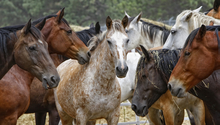The National Veterinary Services Laboratories (NVSL), has confirmed findings of vesicular stomatitis virus (VSV) infection (New Jersey serotype) on premises in Maricopa County, Arizona and Kane County, Utah.

More cases of equine vesicular stomatitis virus
National Veterinary Services Laboratories has confirmed findings of vesicular stomatitis virus infection (New Jersey serotype) on premises in Maricopa County, Arizona and Kane County, Utah.
© 2015 by Kondrashov MIkhail Evgenevich
Three horses on two premises in Maricopa County, Arizona met the case definition of infection with compatible clinical signs andpositive complement fixation antibody titers.
One mule in Kane County, Utah met the case definition of in fection with compatible clinical signs and positive virus isolation. These are the 2015 VSV index cases for Arizona and Utah, respectively.
Additionally, a second premises in Kane County, Utah is under VSV quarantine related to the index case. The equids involved in the Kane County, Utah case had moved from Arizona just prior to identification of clinical signs.
In addition to the two confirmed premises in Maricopa County, Arizona, there are five suspect premises in Arizona under movement control for suspicion of VSV.
Quarantined premises are eligible for release 14 days after the onset of lesions in the last affected animal on the premises. Since the last situation report (4/29/15) one premise in Grant County, New Mexico has been released from quarantine.
Vesicular stomatitis (VS) is a viral blister-forming disease affecting humans and livestock, including horses, cattle, sheep, goats, pigs, llamas, and alpacas. Vesicular stomatitis virus is the only one of the blister-forming viruses to affect horses, which differentiates it from other devastating diseases of livestock such as Foot and Mouth Disease (FMD).
Vesicular stomatitis appears sporadically in the United States, where it is a reportable disease. A veterinarian diagnosing VS must report the case to the state and federal authorities, and the horse and property will be quarantined to avoid spread of the disease.
The incubation period is 2-8 days. Signs of VS in horses include a fever in the early stages, lethargy, and loss of appetite mainly due to the formation of vesicles, the blister-like sores, that form in the mouth. Vesicles are the primary distinguishing sign of VS and may form on the lips, tongue, gums, muzzle, sheath, teats, vulva, and at the coronary bands.
The vesicles burst after a day or two leaving ulcerative sores. Horses with mouth lesions may avoid food and water and may drool copiously, in fact excess salivation is often one of the first signs noted. Horses with coronary band lesions may become lame, and weight loss is not uncommon.
The disease generally runs its course within two weeks. While it causes significant economic loss and pain/debilitation to the horse, VS is generally not fatal.
